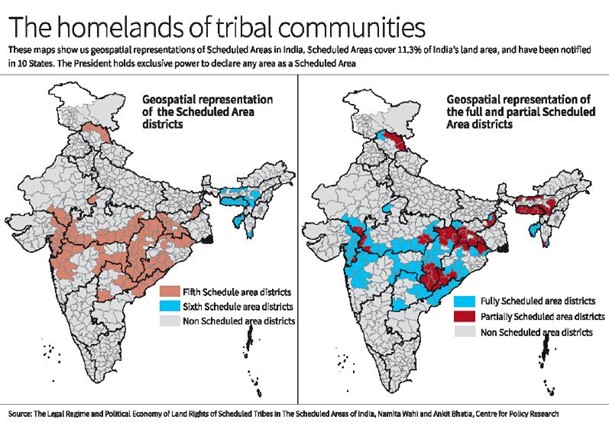- Courses
- GS Full Course 1 Year
- GS Full Course 2 Year
- GS Full Course 3 Year
- GS Full Course Till Selection
- Online Program
- GS Recorded Course
- NCERT (Recorded 500+ Hours)
- Polity Recorded Course
- Geography Recorded Course
- Economy Recorded Course
- AMAC Recorded Course
- Modern India, Post Independence & World History
- Environment Recoded Course
- Governance Recoded Course
- Science & Tech. Recoded Course
- International Relations and Internal Security Recorded Course
- Disaster Management Module Course
- Ethics Recoded Course
- Essay Recoded Course
- Current Affairs Recoded Course
- CSAT
- 5 LAYERED ARJUNA Mentorship
- Public Administration Optional
- ABOUT US
- OUR TOPPERS
- TEST SERIES
- FREE STUDY MATERIAL
- VIDEOS
- CONTACT US
Scheduled Areas in India
Scheduled Areas in India
13-10-2023

Context
India's Scheduled Tribes (STs) constitute 8.6% of the population, residing in various states and union territories. Article 244 of the Indian Constitution is a critical provision for the administration of Scheduled and Tribal Areas.
What are Scheduled Areas?
- About:
- The 11.3% of India's land area that is Scheduled Areas are inhabited by several ST communities, which comprise 8.6% of the nation's population.
- Under the Fifth Schedule, they are listed in the following ten states: Madhya Pradesh, Rajasthan, Gujarat, Maharashtra, Himachal Pradesh, Telangana, Odisha, Jharkhand, Chhattisgarh, and Madhya Pradesh.
- Assam, Meghalaya, Tripura, and Mizoram are the four states included in the Sixth Schedule.
- Kerala requested in 2015 to designate two wards in each of five districts, five-gram panchayats, and 2,133 habitations as Scheduled Areas; the Union government has to approve the proposal.
- Criteria for Identification:
- The considerable tribal population, compactness, reasonable size, viability as an administrative unit, and economic backwardness relative to neighboring areas are the guiding standards for designating an area as a Scheduled Area.
- A recommendation to identify areas with 40% or more tribal population according to the 1951 Census as Scheduled Areas came from the Bhuria Commission or the Scheduled Areas and Scheduled Tribes Commission in 2002.
- Constitutional Provisions and Governance:
- Article 244 (1) applies the Fifth Schedule provisions to Scheduled Areas in states other than Assam, Meghalaya, Tripura, and Mizoram.
- Article 244 (2) applies the Sixth Schedule to the aforementioned states.
- Tribal Advisory Council: The President of India notifies Scheduled Areas, and states with Scheduled Areas establish a Tribal Advisory Council to advise the Governor on ST welfare matters.
- Panchayats (Extension to Scheduled Areas) Act (PESA) of 1996:
- It empowers gram sabhas, granting them substantial authority through direct democracy, prioritizing Local Self-Governance.
- The Bhuria Committee was established in 1995 with the recommendation to incorporate these villages under the panchayat raj system, although this has not yet been implemented.
- India's Scheduled Areas are notified by the President of India. States that have Scheduled Areas must form a Tribal Advisory Council comprised of no more than 20 ST members.
- On issues pertaining to ST welfare that are referred to them, they shall advise the Governor. The President will then receive an annual report from the Governor on the management of Scheduled Areas.
Concerns Related to Scheduled Areas
- A significant portion (59%) of India's ST population lies beyond the scope of Article 244, depriving them of rights guaranteed by legislation pertaining to Scheduled Areas, in spite of appeals from Adivasi organizations.
- One typical bureaucratic response to the lack of functional ST-majority administrative units has been to demand that some portions of Scheduled Areas be denotified.
- The Biological Diversity Act of 2002 and the Right to Fair Compensation and Transparency in Land Acquisition, Rehabilitation, and Resettlement Act of 2013 are two laws that apply to Scheduled Areas and thus deny them rights.

Way Forward
- Regardless of their proximity, all habitations or groups of habitations outside of Scheduled Areas in all States and Union Territories where STs make up the majority of the social group must be designated as Scheduled Areas.
- The boundaries of these villages must be expanded to include, where appropriate, the "community forest resource" area on forest land as defined by the Forest Rights Act (FRA) 2006, as well as the customary boundary within revenue lands made possible by appropriately amending the pertinent State laws.
- In order to make the revenue village, panchayat, taluka, and district truly Scheduled Areas, their existing boundaries will need to be redrawn.
Prelims
Q3. Under which Schedule of the Constitution of India can the transfer of tribal land to private parties for mining be declared null and void? (UPSC-2019)
(a) Third Schedule
(b) Fifth Schedule
(c) Ninth Schedule
(d) Twelfth Schedule
Ans: (b)
Mains
Q. Article 244 of the Indian Constitution relates to the administration of scheduled areas and tribal areas. Analyse the impact of non-implementation of the provisions of the Fifth Schedule on the growth of Left-wing extremism. (UPSC-2013)



